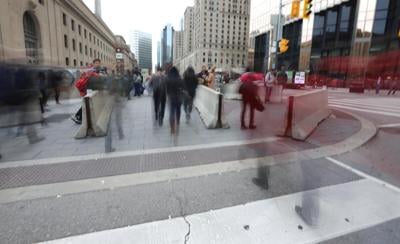The barriers went up soon after the van attack in April 2018. At city hall, Scotiabank Arena and the Rogers Centre, big, concrete ÔÇ£Jersey barriersÔÇØ were installed to thwart potential vehicle attacks. Many are still around.
The busy plaza in front of Union Station also saw barriers installed, creating a human bottleneck in one of the busiest pedestrian areas of the country. More esthetically pleasing barriers were promised, but so far the concrete has .
Other barriers were more subtle, or at least mobile. At celebrations like Pride, New YearÔÇÖs Eve and Nuit Blanche the city now employs ÔÇ£blocker trucksÔÇØ at key intersections and event entrances, placing garbage and dump trucks as well grey-and-black painted TTC ÔÇ£events supportÔÇØ buses in strategic positions.
A city hall insider told me in the past the ║ú¢Ã╔þð╣┘═°Police Services were mainly in charge of these kinds of crowd safety measures, but the Pan AM Games in 2015 was motivation to start planning these measures as part of events themselves. The misogynist, mass killing by van in 2018 meant ║ú¢Ã╔þð╣┘═°became yet another city to suffer a major vehicular terrorist attack, even if ours was a one-man-operation, along with cities like Nice, Barcelona and Charlottesville.
In the realm of public safety and crowd control this is called ÔÇ£Hostile Vehicle Mitigation.ÔÇØ While the phrase does slightly obscure that these hostile vehicles are driven by hostile humans (a semantic point but one many argue is an important specification to make), itÔÇÖs something ║ú¢Ã╔þð╣┘═°.
Well-designed barriers are a part of the streetscape in many places, hiding the fortress-like role they play in plain sight. In European cities, ubiquitous bollards made of metal, stone or concrete are found on the perimeters of public spaces and along sidewalks. Some look sculptural or are designed to thematically match the place they are located. Others are low-profile, simple poles.
║ú¢Ã╔þð╣┘═°has bollards in a few locations, often installed to prevent nuisance parking on sidewalks. These can frequently be found by businesses that see a lot of drop-in business from drivers, like coffee shops, or by automotive repair shops who may have been using the adjacent sidewalks as car storage.
Whenever you see those, you know thereÔÇÖs a neighbourhood story behind them. Grocery stores have long been leaders in bollards that prevent carts from rolling away, and some retailers even have bollards to prevent smash-and-grab theft.
Some concrete bollards in ║ú¢Ã╔þð╣┘═°are historic artifacts: in front of some schools and other locations the old Metro ║ú¢Ã╔þð╣┘═°logo is embedded in them. We need more of these barriers all over, though.
The van attack didnÔÇÖt change some streetscapes at all: conspicuously, the stretch of Yonge in North York where it took place is the same as it was that terrible day.

Bollards have been used elsewhere for years, like at the Vatican.
Shawn MicallefA by Jack Rozdilsky and Edward Snowdon of the department of Disaster and Emergency Management at York University called ÔÇ£The 2018 ║ú¢Ã╔þð╣┘═°Van Attack: Understanding the Disaster by Looking at Vulnerability, Tactics, and MotivesÔÇØ examined TorontoÔÇÖs readiness for future vehicular attacks.
The authors write we must be prepared and not suffer a ÔÇ£failure of imagination in considering the potential for future attack,ÔÇØ but also that the ÔÇ£pervasive threat of gender-driven violence needs to be recognized.ÔÇØ
They go on to differentiate between hard and soft targets. Sites that are controlled with tight security are hard targets while public places with open access are soft, like sidewalks and plazas.
The van attack area of Yonge, the authors found, was the ÔÇ£softest of soft targets.ÔÇØ They point out design elements like minimal difference in traffic lane and sidewalk heights, multiple barrier-free locations and unobstructed sidewalks wide enough for a vehicle.
The authors also noted death and injuries not related to the van attack in the very same area, citing the city of TorontoÔÇÖs own statistics that show between January 2011 and December 2019 there were 143 collisions involving pedestrians, of which 10 involved fatalities or serious injuries.
The authors were careful to say we shouldnÔÇÖt overreact to the van attack and ÔÇ£make streetscapes appear like life during wartime.ÔÇØ Most interesting is they point to the ÔÇ£Reimagining YongeÔÇØ rebuild of this entire stretch as having the potential to make it safer from vehicular threats.
They suggest ║ú¢Ã╔þð╣┘═°consider landscape features, bollards and planters along with strengthened ÔÇ£light structuresÔÇØ like bus shelters, immovable landmarks like statues, fountains and walls, integrated street furniture and higher curbs to prevent future attacks, among other measures.
Yonge in North York is like most streets in ║ú¢Ã╔þð╣┘═°ÔÇö vulnerable to terrorist attack but also everyday vehicular danger, as we saw last week on St. Clair when an SUV crushed Jillian Mendoza, a nanny pushing two children.
While we must not turn our streets into wartime fortresses, and we must keep them open and accessible to all people and their mobility devices, redesigning them to keep people safe from drivers of all kinds, hostile or just negligent, should be a top civic priority.




























